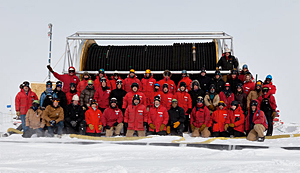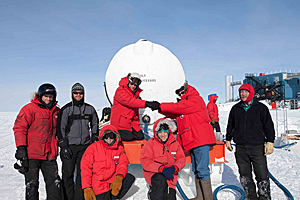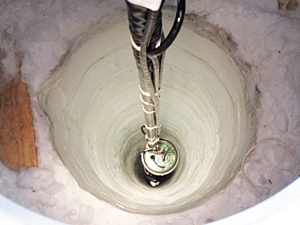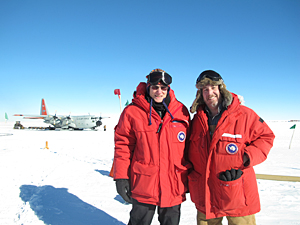



ADVERTISEMENT
- Rozovsky wins prestigious NSF Early Career Award
- UD students meet alumni, experience 'closing bell' at NYSE
- Newark Police seek assistance in identifying suspects in robbery
- Rivlin says bipartisan budget action, stronger budget rules key to reversing debt
- Stink bugs shouldn't pose problem until late summer
- Gao to honor Placido Domingo in Washington performance
- Adopt-A-Highway project keeps Lewes road clean
- WVUD's Radiothon fundraiser runs April 1-10
- W.D. Snodgrass Symposium to honor Pulitzer winner
- New guide helps cancer patients manage symptoms
- UD in the News, March 25, 2011
- For the Record, March 25, 2011
- Public opinion expert discusses world views of U.S. in Global Agenda series
- Congressional delegation, dean laud Center for Community Research and Service program
- Center for Political Communication sets symposium on politics, entertainment
- Students work to raise funds, awareness of domestic violence
- Equestrian team wins regional championship in Western riding
- Markell, Harker stress importance of agriculture to Delaware's economy
- Carol A. Ammon MBA Case Competition winners announced
- Prof presents blood-clotting studies at Gordon Research Conference
- Sexual Assault Awareness Month events, programs announced
- Stay connected with Sea Grant, CEOE e-newsletter
- A message to UD regarding the tragedy in Japan
- More News >>
- March 31-May 14: REP stages Neil Simon's 'The Good Doctor'
- April 2: Newark plans annual 'wine and dine'
- April 5: Expert perspective on U.S. health care
- April 5: Comedian Ace Guillen to visit Scrounge
- April 6, May 4: School of Nursing sponsors research lecture series
- April 6-May 4: Confucius Institute presents Chinese Film Series on Wednesdays
- April 6: IPCC's Pachauri to discuss sustainable development in DENIN Dialogue Series
- April 7: 'WVUDstock' radiothon concert announced
- April 8: English Language Institute presents 'Arts in Translation'
- April 9: Green and Healthy Living Expo planned at The Bob
- April 9: Center for Political Communication to host Onion editor
- April 10: Alumni Easter Egg-stravaganza planned
- April 11: CDS session to focus on visual assistive technologies
- April 12: T.J. Stiles to speak at UDLA annual dinner
- April 15, 16: Annual UD push lawnmower tune-up scheduled
- April 15, 16: Master Players series presents iMusic 4, China Magpie
- April 15, 16: Delaware Symphony, UD chorus to perform Mahler work
- April 18: Former NFL Coach Bill Cowher featured in UD Speaks
- April 21-24: Sesame Street Live brings Elmo and friends to The Bob
- April 30: Save the date for Ag Day 2011 at UD
- April 30: Symposium to consider 'Frontiers at the Chemistry-Biology Interface'
- April 30-May 1: Relay for Life set at Delaware Field House
- May 4: Delaware Membrane Protein Symposium announced
- May 5: Northwestern University's Leon Keer to deliver Kerr lecture
- May 7: Women's volleyball team to host second annual Spring Fling
- Through May 3: SPPA announces speakers for 10th annual lecture series
- Through May 4: Global Agenda sees U.S. through others' eyes; World Bank president to speak
- Through May 4: 'Research on Race, Ethnicity, Culture' topic of series
- Through May 9: Black American Studies announces lecture series
- Through May 11: 'Challenges in Jewish Culture' lecture series announced
- Through May 11: Area Studies research featured in speaker series
- Through June 5: 'Andy Warhol: Behind the Camera' on view in Old College Gallery
- Through July 15: 'Bodyscapes' on view at Mechanical Hall Gallery
- More What's Happening >>
- UD calendar >>
- Middle States evaluation team on campus April 5
- Phipps named HR Liaison of the Quarter
- Senior wins iPad for participating in assessment study
- April 19: Procurement Services schedules information sessions
- UD Bookstore announces spring break hours
- HealthyU Wellness Program encourages employees to 'Step into Spring'
- April 8-29: Faculty roundtable series considers student engagement
- GRE is changing; learn more at April 15 info session
- April 30: UD Evening with Blue Rocks set for employees
- Morris Library to be open 24/7 during final exams
- More Campus FYI >>
3:54 p.m., Dec. 20, 2010----Culminating a decade of planning, innovation and testing, construction of the world's largest neutrino observatory, installed in the ice at the geographic South Pole, was successfully completed Dec. 18, 2010, New Zealand time.
The last of 86 holes had been drilled and a total of 5,160 optical sensors are now installed to form a cubic kilometer of instrumented ice -- of the IceCube Neutrino Observatory -- located at the National Science Foundation's Amundsen-Scott South Pole Station.
The announcement was made in a news release issued jointly by the National Science Foundation (NSF) and the University of Wisconsin-Madison, the lead coordinating institution for the $279 million project, which included the University of Delaware as a major scientific collaborator.
The IceCube Neutrino Observatory is among the most ambitious and complex scientific construction projects ever attempted, encompassing an expanse of almost 200 football fields across and a mile-and-a-half deep in the Antarctic ice sheet. From its vantage point at the end of the world, the observatory provides an innovative means to investigate neutrinos -- fundamental particles that originate in some of the most spectacular phenomena in the universe.
Trillions of neutrinos stream through the human body at any given moment, but they rarely interact with regular matter, and researchers want to know more about them and where they come from.
In the deep, dark stillness of the Antarctic ice, IceCube records the rare collisions of these elusive sub-atomic particles with the atomic nuclei of water molecules of the ice. Some neutrinos come from the sun, while others come from cosmic rays interacting with Earth's atmosphere, and dramatic astronomical sources such as exploding stars in the Milky Way and other distant galaxies.
The size of the observatory is important because it increases the number of potential collisions that can be observed, which appear as flashes of light in the dark, clear ice, making neutrino astrophysics a reality.
Eighty-six strings, each with 60 sensors, make up the main IceCube detector. It was installed using a special hot-water drill, which bored holes to depths between 1,450 and 2,450 meters (0.9 - 1.5 miles) through the ice sheet. Optical sensors attached to cables were then lowered into the holes.
Above each string, on the top of the ice, sit four more sensors, forming the IceTop array. This array combined with the IceCube detector form the IceCube Observatory whose sensors record the neutrino interactions.
A University of Delaware team led by Thomas Gaisser, Martin A. Pomerantz Chaired Professor of Physics and Astronomy, was responsible for installing the IceTop surface array of detectors, which required the painstaking work of freezing digital optical modules in clear ice, without bubbles or cracks.
Gaisser and his research team from the Bartol Research Institute reported their efforts over the past four years through a popular blog series and a classroom educational experience that included a “Phone Call to the Deep Freeze,” connecting the Antarctic team with secondary school students in Delaware and across the U.S.
“With IceCube and its IceTop array on the surface working together, we will have a unique and unprecedented detector for neutrino astronomy and for cosmic-ray physics,” Gaisser said.
To build the observatory, all project personnel, equipment, food and detector components had to be transported to Antarctica from around the globe, flown in via ski-equipped C-130 cargo aircraft from McMurdo Station near the Antarctic coast, more than 800 air miles away.
The construction team worked only during the relatively warm and short Antarctic summer --from November through February, when the sun shines 24 hours a day.
“IceCube is not only a magnificent observatory for fundamental astrophysical research, it is the kind of ambitious science that can only be attempted through the cooperation -- the science diplomacy, if you will -- of many nations working together in the finest traditions of Antarctic science toward a single goal,” said Karl A. Erb, director of NSF's Office of Polar Programs.
In addition to researchers at universities and research labs in the U.S., Belgium, Germany and Sweden -- the countries that funded the observatory -- IceCube data are being analyzed by the larger IceCube Collaboration, which also includes researchers from Barbados, Canada, Japan, New Zealand, Switzerland and the United Kingdom.


